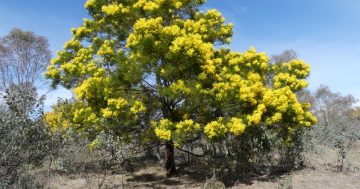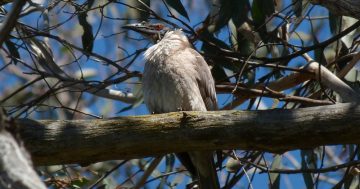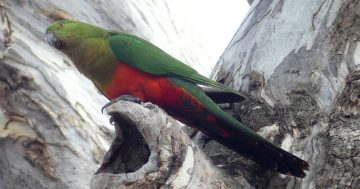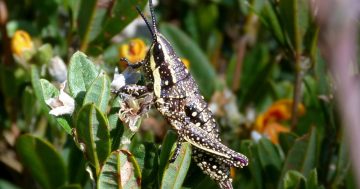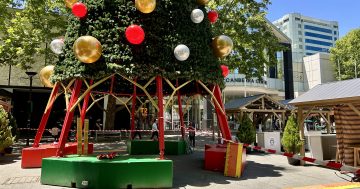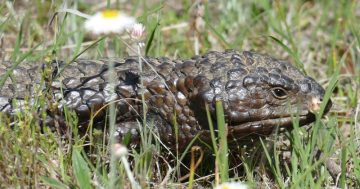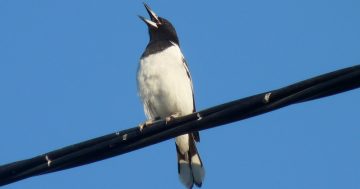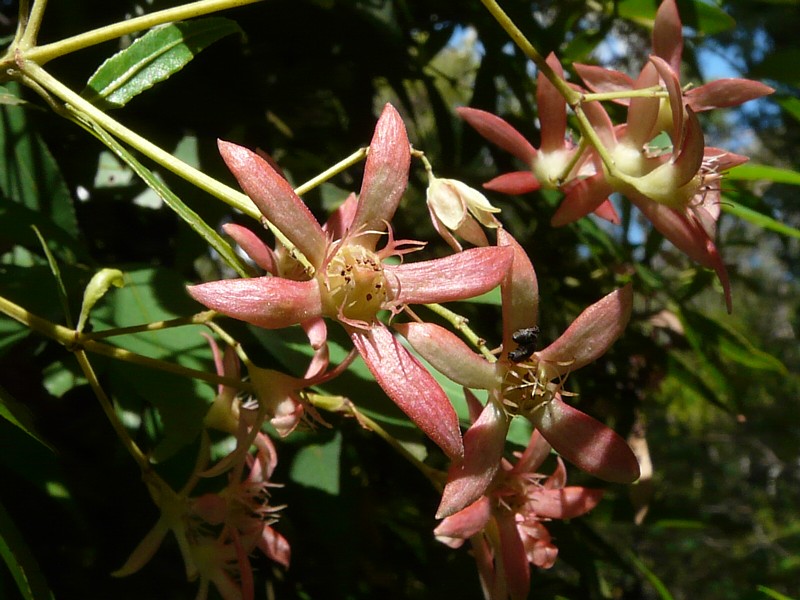
NSW Christmas bush in a coastal rainforest gully. Photo: Ian Fraser.
I know it’s not quite Christmas yet, but this is my last column before 25 December so it’s now or never for me.
Most of us are quite familiar with the Christmas bush, but are we all thinking about the same one? For instance, I’ve got two different ones growing in my garden alone.
One is the Christmas bush I grew up with in Adelaide. In South Australia and Tasmania, the name refers to a shrub which grows commonly on dry hillsides around Canberra – but under a different name.
I normally avoid using ‘proper’ names for plants and animals in these columns, but in this circumstance I must do it to avoid confusion.
The South Australian Christmas bush is a large prickly shrub called Bursaria spinosa, although in the ACT it’s more commonly called sweet bursaria or native blackthorn.
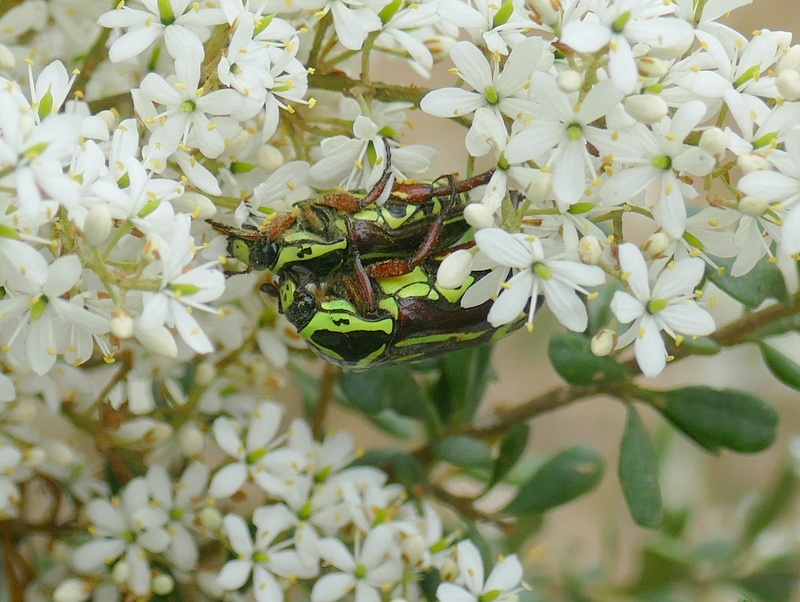
Fiddler beetles in Canberra, among flowers of native blackthorn, or South Australian Christmas bush. Photo: Ian Fraser.
It’s a hardy plant that is quite capable of dealing with both frosts and drought. Its prickly foliage makes it very popular with small birds such as wrens and thornbills, and both roost and nest in it, relatively safe from predators.
Like other Christmas bushes, it is named because it flowers at the festive time of year, and its flowering is spectacular: a mass of sweet-smelling white flowers which are irresistible to thousands of native bees, wasps, flies, butterflies and beetles.
The other Christmas bush in our yard is known as Victorian Christmas bush, although this is a bit cheeky as it grows in wet mountain gullies from Tasmania to southern Queensland.
The growing locations include lush treefern creeklines in the lower Brindabellas, such as along Warks Road.
It’s biological name is Prostanthera lasianthos, one of the beautifully aromatic native mint bushes, in the same family as many scented garden herbs.
Its mauve-white tube flowers with yellow blotches weigh down the branches in December so I can hardly get to my compost bin while it’s displaying – not that I’m complaining!
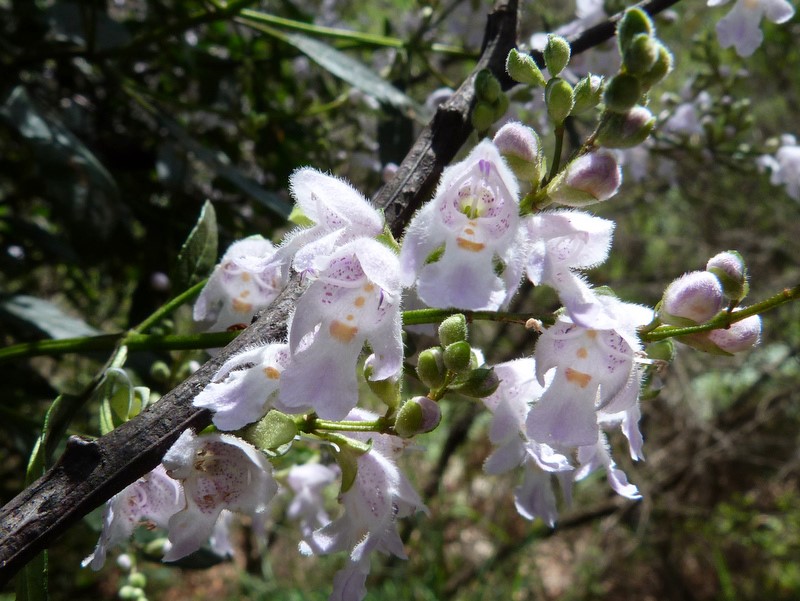
Victorian Christmas bush flowers in the Brindabellas. Photo: Ian Fraser.
To anyone from Sydney or the South Coast, the NSW Christmas bush is something entirely different again.
This one, with the splendid mouthful of a name, Ceratopetalum gummeriferum, tends to live in coastal rainforest gullies so if not planted in a very sheltered spot it is unlikely to thrive in a Canberra garden. But different rules apply to the wizard-like horticulturalists at the Australian National Botanic Gardens, of course.
To my mind, it’s more of a tree than a shrub, but I won’t argue. In this case, it’s not really the flowers which are so striking in late December.
These are small and white, but when they’ve finished they drop off and the inconspicuous flower parts which surround them, called sepals, suddenly grow large and turn a glowing red. I’m sure this must be to attract an animal, probably a bird, to eat and distribute the seeds, but we just don’t know for sure.
Apparently the Christmas bush name was first used for the plant in 1838 by a precocious 18-year-old called James Martin in a book of essays called The Australian Sketch Book. He ended his career as Chief Justice of NSW.
At one point, vast quantities of the red ‘flowers’ were cut out of the bush and sold in Sydney markets, but fortunately that fad has faded and the trees are still common enough in the right habitat. You may well enjoy them on drives and walks at the coast this Christmas.
Western Australians have their own Christmas tree, which is very different again, with glowing golden spikes of flowers at the end of the year. This is Nuytsia floribunda, a root parasite in the same family as the tree-dwelling mistletoes.
It is very hard to cultivate so you’ll just have to go west – when we can again do so – to enjoy it.

With the ground softened by recent rain, Christmas beetles should be emerging very soon. Photo: Ian Fraser.
Finally, I can’t really write about natural Christmassy things in Canberra without mentioning Christmas beetles, the 30-odd species of familiar and often beautiful scarab beetles which spend most of the year underground as larvae, feeding on grass roots.
After spring and early summer rains, they hatch and fly up to munch on the new shoots of eucalypts. If the rains don’t come, they can’t dig through the hard soil and they die in their burrows. By the end of 2019, after years of drought, there were few Christmas beetles in Canberra, but I’m hoping this year we’ll be enjoying them again.
I hope your Christmas brings peace and relief from a trying year, and I look forward to exploring more of the natural world with you in 2022.
Ian Fraser is a Canberra naturalist, conservationist and author. He has written on all aspects of natural history, advised the ACT Government on biodiversity, and published multiple guides to the region’s flora and fauna.
Original Article published by Ian Fraser on Riotact.



